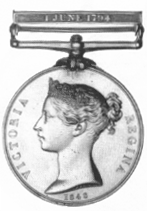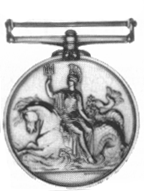| Clasp | Battle or action | Date | Comments |
|---|
| Beaver 31 March 1804 | Boats of Scorpion and Beaver captured the Dutch brig Atalante | 31 March 1804 | Unissued
Britain vs Batavian Republic |
| Scorpion 31 March 1804 | Boats of Scorpion and Beaver captured the Dutch brig Atalante | 31 March 1804 | Britain vs Batavian Republic |
| San Fiorenzo 14 Feby. 1805 | Capture of Psyché | 14 February 1805 | Britain vs France |
| Trafalgar | Battle of Trafalgar | 21 October 1805 | Britain vs France & Spain |
| 4 Novr. 1805 | Battle of Cape Ortegal | 4 November 1805 | Britain vs France |
| St. Domingo | Battle of San Domingo | 6 February 1806 | Britain vs France |
| Blanche 18 July 1806 | Capture of French frigate Guerriere | 18 July 1806 | Britain vs France |
| 21 Jan. Boat Service 1807 | Boats of Galatea vs Lynx | 21 January 1807 | Britain vs France |
| 19 April Boat Service 1807 | Boats of Richmond capture a privateer | 19 April 1807 | Unissued
Britain vs. France |
| Ann 24 Novr. 1807 | Capture of Spanish lugger privateer and action with ten gunboats and surrender of two | 24 November 1807 | Unissued
Britain vs Spain |
| Sappho 2 March 1808 | Capture of brig Admiral Yawl | 2 March 1808 | Britain vs Denmark-Norway |
| San Fiorenzo 8 March 1808 | Capture of Piémontaise | 8 March 1808 | Britain vs France |
| 28 Nov. Boat Service 1808 | Boats of Heureux attack a battery and capture a brig and a schooner | 29 November 1808 | Britain vs France |
| Onyx 1 Jany. 1809 | Recapture of Manly | 1 January 1809 | Britain vs the Batavian Republic |
| Martinique | Invasion of Martinique (1809) | 30 January – 24 February 1809 | Britain vs France |
| Basque Roads 1809 | Battle of the Basque Roads | 11–25 April 1809 | Britain vs France |
| 25 July Boat Service 1809 | Boats of Fawn in action with a cutter and the schooner Guadaloupe, which they captured | 25 July 1809 | Unissued
Britain vs France |
| 25 July Boat Service 1809 | Boats of Cerberus, Minotaur, Princess Caroline, and Prometheus capture Russian gunboats near Fredrikshamn, Gulf of Finland | 25 July 1809 | Britain vs Russia |
| Guadaloupe | Invasion of Guadeloupe (1810) | 28 January – 6 February 1810 | Britain vs France |
| Thistle 10 Feby. 1810 | Capture of Havik | 10 February 1810 | Unissued
Britain vs The Netherlands |
| Boat engagement, Christian 7th | Boats from HMS Christian VII, under Sir Joseph Sydney Yorke, HMS Armide and HMS Seine, attack 9 French gun-boats in the Basque Roads, capturing 1. | 13 February 1810 | Britain vs France |
| Arrow 6 April 1811 | Action with chasse-marees and batteries off the French coast | 6 April 1811 | Unissued
Britain vs France |
| Java | Invasion of Java (1811) | August – September 1811 | Britain vs The Netherlands |
| Lissa | Battle of Lissa (1811) | 13 March 1811 | Britain vs France and Venice |
| Anholt 27 March 1811 | Battle of Anholt | 27 March 1811 | Britain vs Denmark-Norway |
| Off Mardoe 6 July 1812 | Battle of Lyngør | 6 July 1812 | Britain vs Denmark-Norway |
| 21 March Boat Service 1813 | Boats of Brev Drageren and Blazer capture gunboats Jonge-Troutman and Liebe | 21 March 1813 | Britain vs Denmark |
| St Sebastian | Siege of San Sebastián | August – September 1813 | Britain & Portugal vs France |
| Cyane 16 Jany. 1814 | Capture of Alcmène & Iphigénie | 16 January 1814 | Britain vs France |



